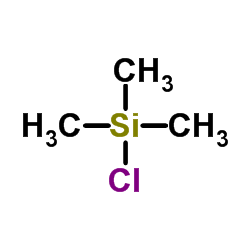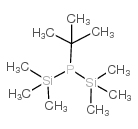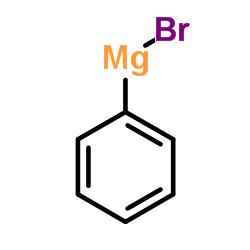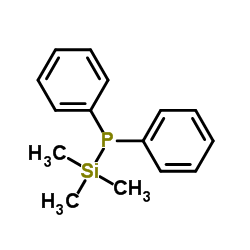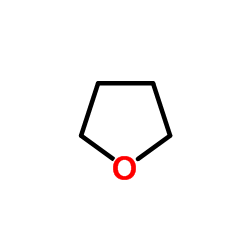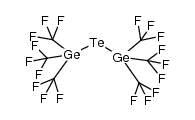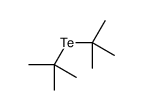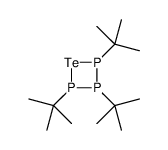4551-16-0
| 中文名 | (双(三甲基甲硅烷基))碲化 |
|---|---|
| 英文名 | (bis(trimethylsilyl))telluride |
| 英文别名 |
hexamethyl-disilatellane
Sulfuric acid,TMS Bis-trimethylsilyl-tellurid Bis(trimethylsilyl)telluride MFCD00143782 Schwefelsaeure-bis-trimethylsilylester sulfuric acid bis-trimethylsilanyl ester |
| 密度 | 0.97 |
|---|---|
| 沸点 | 74ºC (11 mmHg) |
| 熔点 | 13.5ºC |
| 分子式 | C6H18Si2Te |
| 分子量 | 273.97800 |
| 精确质量 | 276.00100 |
| LogP | 2.36040 |
| 外观性状 | 透明橙色-棕色液体 |
| 储存条件 | 密封储存,储存于阴凉、干燥的库房。常用氮气保护。 |
| 稳定性 | 常温常压下稳定,避免与不相容材料,湿空气,水接触。 与强氧化剂反应。 |
| 计算化学 | 1、 疏水参数计算参考值(XlogP):2.9 2、 氢键供体数量:1 3、 氢键受体数量:4 4、 可旋转化学键数量:2 5、 互变异构体数量:4 6、 拓扑分子极性表面积(TPSA):61.6 7、 重原子数量:20 8、 表面电荷:0 9、 复杂度:407 10、 同位素原子数量:0 11、 确定原子立构中心数量:0 12、 不确定原子立构中心数量:0 13、 确定化学键立构中心数量:0 14、 不确定化学键立构中心数量:0 15、 共价键单元数量:1 |
| 更多 | 1. 性状:黄色或棕色透明液体 2. 密度(g/mL,20℃):0.97 3. 相对蒸汽密度(g/mL,空气=1):未确定 4. 熔点(ºC):13.5 5. 沸点(ºC,常压):未确定 6. 沸点(ºC,11mmHg):74 7. 折射率(n20/D):未确定 8. 闪点(ºC):未确定 9. 比旋光度(º):未确定 10. 自燃点或引燃温度(ºC):未确定 11. 蒸气压(mPa,20ºC):未确定 12. 饱和蒸气压(kPa,25ºC):未确定 13. 燃烧热(KJ/mol):未确定 14. 临界温度(ºC):未确定 15. 临界压力(KPa):未确定 16. 油水(辛醇/水)分配系数的对数值:未确定 17. 爆炸上限(%,V/V):未确定 18. 爆炸下限(%,V/V):未确定 19. 溶解性:未确定 |
Synonym:None Section 2 - COMPOSITION, INFORMATION ON INGREDIENTS
Risk Phrases: None Listed. Section 3 - HAZARDS IDENTIFICATION EMERGENCY OVERVIEW
Moisture sensitive.Stench. Potential Health Effects Eye: May cause eye irritation. Skin: May cause skin irritation. Ingestion: May cause irritation of the digestive tract. May cause cardiac disturbances. The toxicological properties of this substance have not been fully investigated. May cause central nervous system depression. May cause cyanosis (bluish discoloration of skin due to deficient oxygenation of the blood). Inhalation: May cause respiratory tract irritation. The toxicological properties of this substance have not been fully investigated. May cause cardiac abnormalities. Inhalation at high concentrations may cause CNS depression and asphixiation. Chronic: Chronic exposure may cause liver damage. Section 4 - FIRST AID MEASURES Eyes: Flush eyes with plenty of water for at least 15 minutes, occasionally lifting the upper and lower eyelids. Get medical aid. Skin: Get medical aid. Flush skin with plenty of water for at least 15 minutes while removing contaminated clothing and shoes. Wash clothing before reuse. Ingestion: Never give anything by mouth to an unconscious person. Get medical aid. Do NOT induce vomiting. If conscious and alert, rinse mouth and drink 2-4 cupfuls of milk or water. Inhalation: Remove from exposure and move to fresh air immediately. If not breathing, give artificial respiration. If breathing is difficult, give oxygen. Get medical aid. Notes to Physician: Section 5 - FIRE FIGHTING MEASURES General Information: As in any fire, wear a self-contained breathing apparatus in pressure-demand, MSHA/NIOSH (approved or equivalent), and full protective gear. During a fire, irritating and highly toxic gases may be generated by thermal decomposition or combustion. Vapors may be heavier than air. They can spread along the ground and collect in low or confined areas. Containers may explode when heated. Non-combustible, substance itself does not burn but may decompose upon heating to produce irritating, corrosive and/or toxic fumes. Runoff from fire control or dilution water may cause pollution. Extinguishing Media: Use water spray to cool fire-exposed containers. Do NOT get water inside containers. For small fires, use dry chemical, carbon dioxide, or water spray. For large fires, use water spray, fog or regular foam. Section 6 - ACCIDENTAL RELEASE MEASURES General Information: Use proper personal protective equipment as indicated in Section 8. Spills/Leaks: Absorb spill with inert material (e.g. vermiculite, sand or earth), then place in suitable container. Avoid runoff into storm sewers and ditches which lead to waterways. Clean up spills immediately, observing precautions in the Protective Equipment section. Provide ventilation. Do not get water inside containers. Section 7 - HANDLING and STORAGE Handling: Wash thoroughly after handling. Avoid breathing dust, vapor, mist, or gas. Avoid contact with eyes, skin, and clothing. Keep container tightly closed. Avoid ingestion and inhalation. Do not allow contact with water. Use only in a chemical fume hood. Keep from contact with moist air and steam. Storage: Store in a tightly closed container. Keep under a nitrogen blanket. Store in a cool, dry, well-ventilated area away from incompatible substances. Store protected from moisture. Section 8 - EXPOSURE CONTROLS, PERSONAL PROTECTION Engineering Controls: Use process enclosure, local exhaust ventilation, or other engineering controls to control airborne levels below recommended exposure limits. Facilities storing or utilizing this material should be equipped with an eyewash facility and a safety shower. Exposure Limits CAS# 4551-16-0: United Kingdom, WEL - TWA: (listed as tellurium compounds, n.o.s. 0.1 mg/m3 TWA (except hydrogen telluride, as Te) United Kingdom, WEL - STEL: (listed as tellurium compounds, n.o.s 0.3 mg/m3 STEL (except hydrogen telluride, as Te) United States OSHA: 0.1 mg/m3 TWA (listed under Tellurium).0.1 m TWA (as Te) (listed under Tellurium compounds, n.o.s.). Belgium - TWA: (listed as tellurium compounds, n.o.s.): 0.1 mg/m3 (as Te) France - VME: (listed as tellurium compounds, n.o.s.): 0.1 mg/m3 (as Te, except tellurium hexafluoride) Germany: (listed as tellurium compounds, n.o.s.): 0.1 mg/m3 VME ( Te, except tellurium hexafluoride) Malaysia: (listed as tellurium compounds, n.o.s.): 0.1 mg/m3 TWA Te, except hydrogen telluride) Netherlands: (listed as tellurium compounds, n.o.s.): 0.1 mg/m3 M (as Te) Russia: (listed as tellurium): 0.01 mg/m3 TWA Spain: (listed as tellurium): 0.1 mg/m3 VLA-ED Personal Protective Equipment Eyes: Wear appropriate protective eyeglasses or chemical safety goggles as described by OSHA's eye and face protection regulations in 29 CFR 1910.133 or European Standard EN166. Skin: Wear appropriate protective gloves to prevent skin exposure. Clothing: Wear appropriate protective clothing to prevent skin exposure. Respirators: Follow the OSHA respirator regulations found in 29 CFR 1910.134 or European Standard EN 149. Use a NIOSH/MSHA or European Standard EN 149 approved respirator if exposure limits are exceeded or if irritation or other symptoms are experienced. Section 9 - PHYSICAL AND CHEMICAL PROPERTIES Physical State: Clear liquid Color: orange - brown Odor: stench pH: Not available. Vapor Pressure: Not available. Viscosity: Not available. Boiling Point: 74 deg C @ 11 mm Hg Freezing/Melting Point: 13.5 deg C Autoignition Temperature: Not applicable. Flash Point: Not applicable. Explosion Limits, lower: Not available. Explosion Limits, upper: Not available. Decomposition Temperature: Solubility in water: Specific Gravity/Density: .9700 g/cm3 Molecular Formula: C6H18Si2Te Molecular Weight: 273.97 Section 10 - STABILITY AND REACTIVITY Chemical Stability: Stable under normal temperatures and pressures. Conditions to Avoid: Moisture, excess heat, exposure to moist air or water. Incompatibilities with Other Materials: Moisture, oxidizing agents. Hazardous Decomposition Products: Carbon monoxide, irritating and toxic fumes and gases, carbon dioxide, silicon dioxide. Hazardous Polymerization: Has not been reported. Section 11 - TOXICOLOGICAL INFORMATION RTECS#: CAS# 4551-16-0 unlisted. LD50/LC50: Not available. Carcinogenicity: Bis(trimethylsilyl)telluride - Not listed by ACGIH, IARC, or NTP. Section 12 - ECOLOGICAL INFORMATION Section 13 - DISPOSAL CONSIDERATIONS Dispose of in a manner consistent with federal, state, and local regulations. Section 14 - TRANSPORT INFORMATION IATA Shipping Name: TELLURIUM COMPOUND, N.O.S. Hazard Class: 6.1 UN Number: 3284 Packing Group: III IMO Shipping Name: TELLURIUM COMPOUND, N.O.S. Hazard Class: 6.1 UN Number: 3284 Packing Group: III RID/ADR Shipping Name: TELLURIUM COMPOUND, N.O.S. Hazard Class: 6.1 UN Number: 3284 Packing group: III Section 15 - REGULATORY INFORMATION European/International Regulations European Labeling in Accordance with EC Directives Hazard Symbols: Not available. Risk Phrases: Safety Phrases: S 24/25 Avoid contact with skin and eyes. WGK (Water Danger/Protection) CAS# 4551-16-0: No information available. Canada None of the chemicals in this product are listed on the DSL/NDSL list. CAS# 4551-16-0 is not listed on Canada's Ingredient Disclosure List. US FEDERAL TSCA CAS# 4551-16-0 is not listed on the TSCA inventory. It is for research and development use only. SECTION 16 - ADDITIONAL INFORMATION N/A |
| 安全声明 (欧洲) | S24/25 |
|---|



